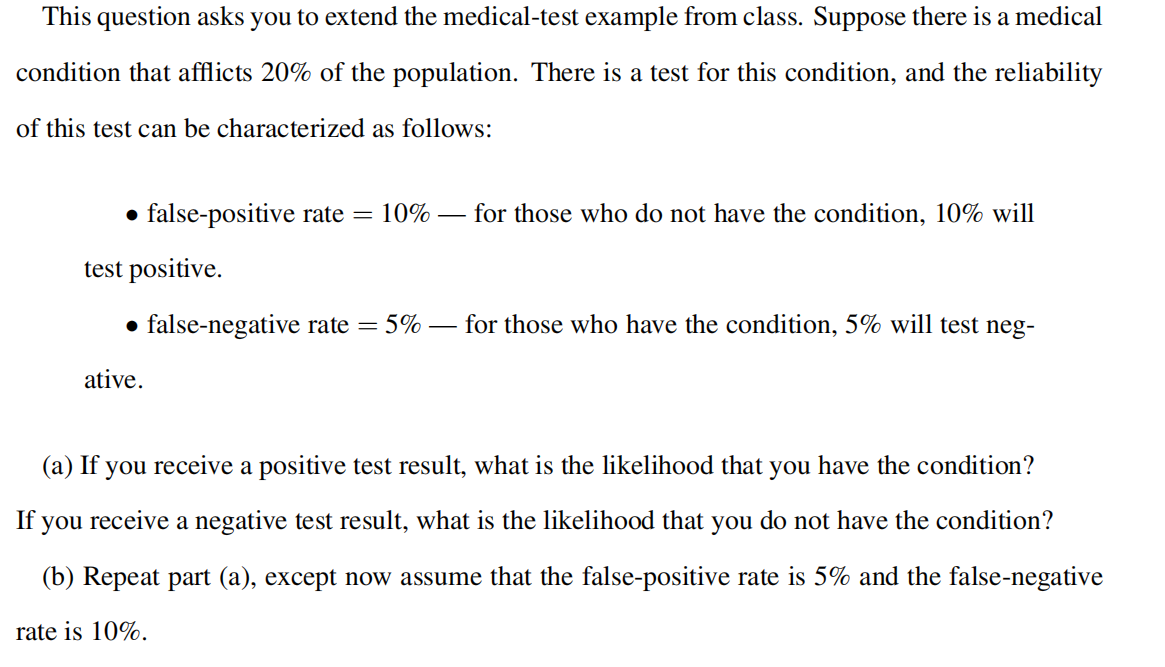This question asks you to extend the medical-test example from class. Suppose there is a medical condition that afflicts 20% of the population. There is a test for this condition, and the reliability of this test can be characterized as follows: false-positive rate = 10% for those who do not have the condition, 10% will test positive. false-negative rate = 5% for those who have the condition, 5% will test neg- ative. (a) If you receive a positive test result, what is the likelihood that you have the condition? If you receive a negative test result, what is the likelihood that you do not have the condition? (b) Repeat part (a), except now assume that the false-positive rate is 5% and the false-negative rate is 10%.
This question asks you to extend the medical-test example from class. Suppose there is a medical condition that afflicts 20% of the population. There is a test for this condition, and the reliability of this test can be characterized as follows: false-positive rate = 10% for those who do not have the condition, 10% will test positive. false-negative rate = 5% for those who have the condition, 5% will test neg- ative. (a) If you receive a positive test result, what is the likelihood that you have the condition? If you receive a negative test result, what is the likelihood that you do not have the condition? (b) Repeat part (a), except now assume that the false-positive rate is 5% and the false-negative rate is 10%.
College Algebra
7th Edition
ISBN:9781305115545
Author:James Stewart, Lothar Redlin, Saleem Watson
Publisher:James Stewart, Lothar Redlin, Saleem Watson
Chapter9: Counting And Probability
Section9.3: Binomial Probability
Problem 2E: If a binomial experiment has probability p success, then the probability of failure is...
Related questions
Question

Transcribed Image Text:This question asks you to extend the medical-test example from class. Suppose there is a medical
condition that afflicts 20% of the population. There is a test for this condition, and the reliability
of this test can be characterized as follows:
• false-positive rate = 10%
for those who do not have the condition, 10% will
test positive.
for those who have the condition, 5% will test neg-
• false-negative rate = 5%
ative.
(a) If you receive a positive test result, what is the likelihood that you have the condition?
If you receive a negative test result, what is the likelihood that you do not have the condition?
(b) Repeat part (a), except now assume that the false-positive rate is 5% and the false-negative
rate is 10%.
Expert Solution
This question has been solved!
Explore an expertly crafted, step-by-step solution for a thorough understanding of key concepts.
Step by step
Solved in 5 steps with 5 images

Recommended textbooks for you

College Algebra
Algebra
ISBN:
9781305115545
Author:
James Stewart, Lothar Redlin, Saleem Watson
Publisher:
Cengage Learning


Holt Mcdougal Larson Pre-algebra: Student Edition…
Algebra
ISBN:
9780547587776
Author:
HOLT MCDOUGAL
Publisher:
HOLT MCDOUGAL

College Algebra
Algebra
ISBN:
9781305115545
Author:
James Stewart, Lothar Redlin, Saleem Watson
Publisher:
Cengage Learning


Holt Mcdougal Larson Pre-algebra: Student Edition…
Algebra
ISBN:
9780547587776
Author:
HOLT MCDOUGAL
Publisher:
HOLT MCDOUGAL